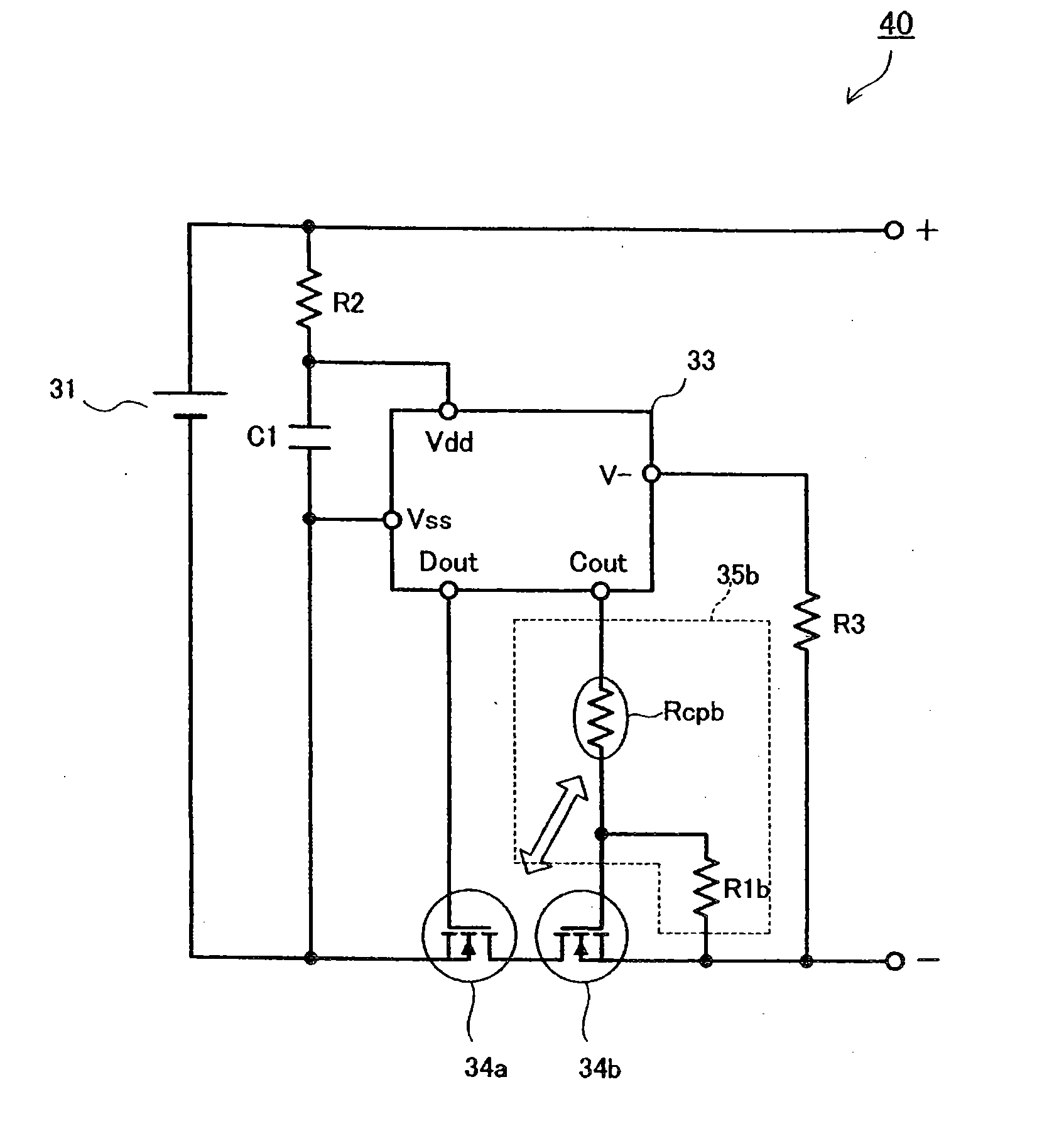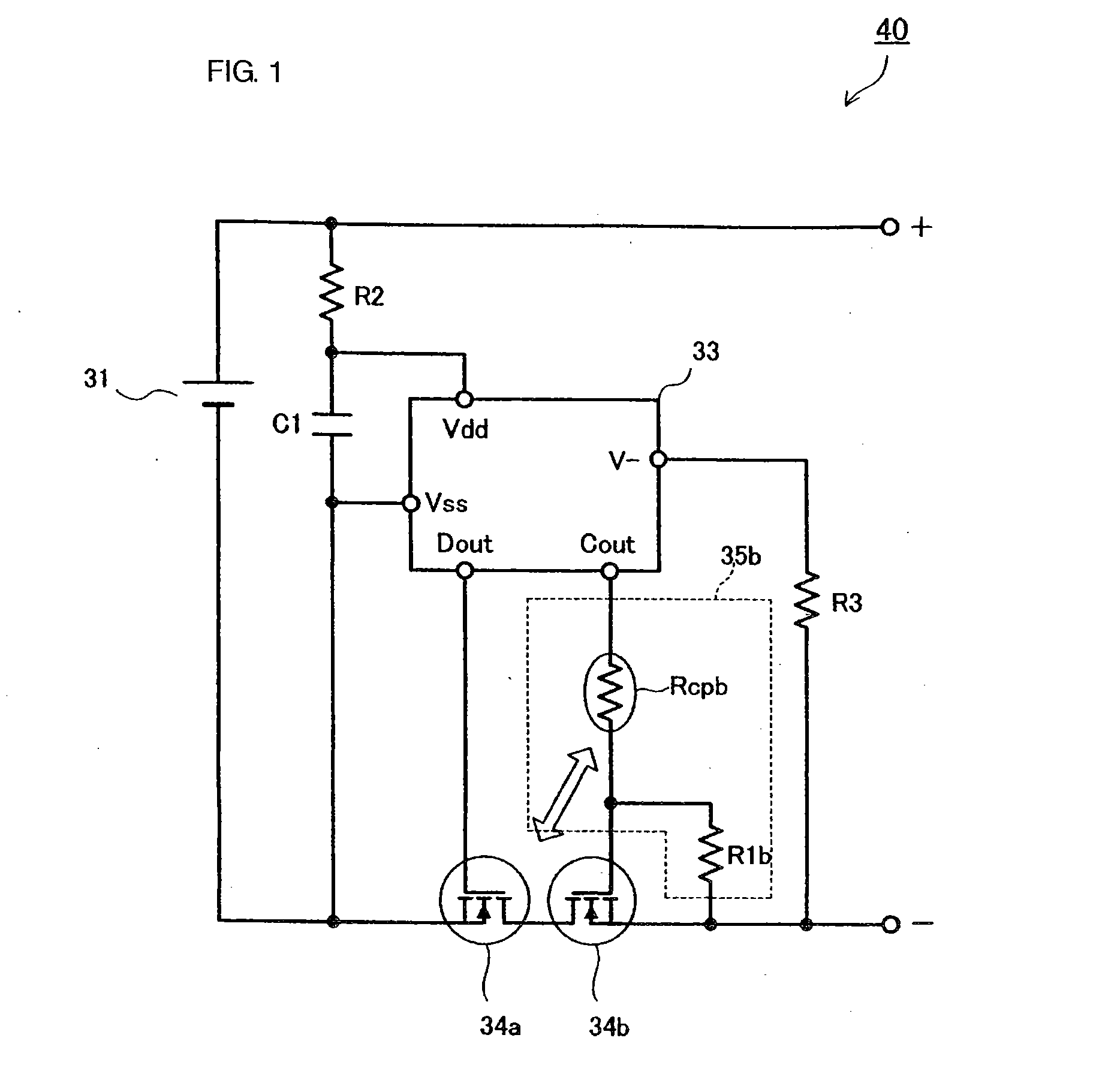Battery pack protection circuit and battery pack
- Summary
- Abstract
- Description
- Claims
- Application Information
AI Technical Summary
Benefits of technology
Problems solved by technology
Method used
Image
Examples
first embodiment
[0064] A structure of a battery pack protection circuit and a battery pack will be described below with reference to FIG. 1.
[0065]FIG. 1 is a circuit diagram of a battery pack 40 provided with a battery pack protection circuit. A first switching element 34a and a second switching element 34b are disposed in series in a charge / discharge path of a battery cell 31. In a protective control circuit 33, a grounding terminal Vss thereof is connected to a negative pole of the battery cell 31, and a terminal Vdd is connected via a resistor R2 to a positive pole of the battery cell 31. A capacitor C1 for eliminating a noise signal is connected between the terminals Vdd and Vss. A resistor R3 is connected between a terminal V− of the protective control circuit 33 and a minus (−) terminal of the battery pack 40.
[0066] The first and second switching elements 34a and 34b each comprise an FET. The protective control circuit 33 is composed of a semiconductor integrated circuit and is provided wit...
second embodiment
[0077] A structure of a battery pack protection circuit and a battery pack will be described below with reference to FIG. 2.
[0078] In the example shown in FIG. 1, a single ceramic positive temperature coefficient thermistor is used. In the second embodiment, a plurality of ceramic positive temperature coefficient thermistors which are respectively thermally connected to different parts are used. That is, a series circuit including a positive temperature coefficient thermistor Rcp1 for battery cell use and a positive temperature coefficient thermistor Rcp2 for switching element use is inserted between a gate control terminal Cout of a protective control circuit 33 and a gate of a second switching element 34b. A resistor R1b is connected between a source and the gate of the second switching element 34b. The resistor R1b and the two ceramic positive temperature coefficient thermistors Rcp1 and Rcp2 constitute a switching element control circuit 35b. The remainder of the structure is t...
third embodiment
[0081] A structure of a battery pack protection circuit and a battery pack 40 will be described below with reference to FIG. 3.
[0082] In the examples shown in FIGS. 1 and 2, the switching element control circuit 35b is provided in the control signal path of the second switching element 34b. In the third embodiment, a switching element control circuit 35a is also provided in the control signal path of the first switching element 34a. That is, a ceramic positive temperature coefficient thermistor Rcpa which is thermally connected to the first switching element 34a is inserted between the gate of the first switching element 34a and the gate control terminal Dout of the protective control circuit 33, and a resistor R1a is connected between the gate and source of the switching element 34a. The resistor R1a and the ceramic positive temperature coefficient thermistor Rcpa constitute the switching element control circuit 35a. The remainder of the structure is the same as that shown in FIG....
PUM
 Login to View More
Login to View More Abstract
Description
Claims
Application Information
 Login to View More
Login to View More - R&D
- Intellectual Property
- Life Sciences
- Materials
- Tech Scout
- Unparalleled Data Quality
- Higher Quality Content
- 60% Fewer Hallucinations
Browse by: Latest US Patents, China's latest patents, Technical Efficacy Thesaurus, Application Domain, Technology Topic, Popular Technical Reports.
© 2025 PatSnap. All rights reserved.Legal|Privacy policy|Modern Slavery Act Transparency Statement|Sitemap|About US| Contact US: help@patsnap.com



